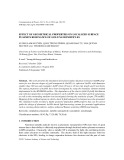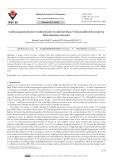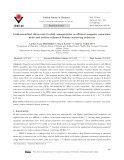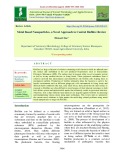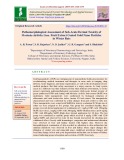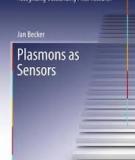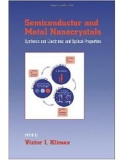
Gold particles
-
Ebook "Laser fragmentation and melting of particles" gives a general understandable introduction into the field of laser fragmentation and melting of particles. The presented state of the art summarizes the comparably young method of laser fragmentation of particles and the even younger method of laser melting of particles.
 272p
272p  tracanhphuonghoa1007
tracanhphuonghoa1007
 22-04-2024
22-04-2024
 3
3
 2
2
 Download
Download
-
Ebook "Crystallization of nanoscaled colloids" deals with the processes that create ordered assemblies from disordered nanoparticles. Ordered packings of nanoscale particles can exhibit unusual properties. This work investigates the self-assembly of such particles, a process widely employed for the generation of ordered structures, but not yet well understood. In situ methods are used to observe the assembly of sub-micron polymer lattices and sub-10 nm gold particles into crystalline monolayers and aggregates.
 138p
138p  coduathanh1122
coduathanh1122
 27-03-2024
27-03-2024
 3
3
 1
1
 Download
Download
-
In this paper, we present simulation results for the LSPR characteristics of spherical AuNPs and triangular AuNPs with an average size below 100 nm. The effect of the particles’ shape, size as well as the surrounding medium, and the polarization of incident light, the inter-particle separation distance between NPs were examined.
 11p
11p  vispiderman
vispiderman
 15-06-2023
15-06-2023
 4
4
 2
2
 Download
Download
-
Gold nanoparticles (AuNPs) with average particle sizes of 13.3 nm were synthesized by γrays irradiation of 1.0 mM Au3+ solutions using low molecular weight β-glucan extracted from yeast cell wall as a stabilizer. The UV-Vis spectra and TEM images were used to analyze the optical characteristic and particle size of AuNPs.
 6p
6p  vicedric
vicedric
 08-02-2023
08-02-2023
 2
2
 1
1
 Download
Download
-
A glassy carbon electrode, modified with gold nanoparticles/over-oxidized poly-eriochrome black T film, was fabricated for sensitive determination of As(III) by stripping voltammetry in an acidic medium. The electrode surface properties were characterized by cyclic voltammetry, electrochemical impedance spectroscopy, scanning electron microscope (SEM), and X-ray photoelectron spectroscopy (XPS).
 15p
15p  lyhuyenthu
lyhuyenthu
 31-01-2023
31-01-2023
 7
7
 1
1
 Download
Download
-
Gold nanochannels were prepared by plating electrolessly gold within the pores of polycarbonate filter membranes (PCTMs). These PCTMs with cylindrical Au nanotubules of uniform radius and high density can be used as a convenient model system to investigate the mechanism of particle transport through nanotubules. The transport properties of phenol through a modified Au nanotubule membrane were studied.
 9p
9p  langthannam
langthannam
 29-12-2021
29-12-2021
 4
4
 0
0
 Download
Download
-
Magnetic and optical bifunctional nanoparticles that combine easy separation, preconcentration, and efficient SERS capabilities have been fabricated with high sensitivity and reproducibility through a low-cost method. These gold nanoparticles attached on magnetic silica-coated cobalt nanospheres (Co@SiO2 /AuNPs) display the advantage of strong resonance absorption due to gaps at nanoscale between neighboring metal nanoparticles bringing large field enhancements, known as “hot spots”.
 12p
12p  tudichquannguyet
tudichquannguyet
 29-11-2021
29-11-2021
 10
10
 1
1
 Download
Download
-
Biofilm is a large collection of colonies containing sessile bacteria which are adhered onto the surface and embedded in the self produced biopolymers such as Extracellular Polymeric Substances (EPS). The surface may be present either in soil or aquatic system as well as in any medical devices or living tissue. These polymeric substances form a cohesive network that interconnects and immobilizes the biofilm cells helping them in mechanical stability.
 18p
18p  trinhthamhodang9
trinhthamhodang9
 16-12-2020
16-12-2020
 10
10
 1
1
 Download
Download
-
The size, shape, and surface morphology of NP‟s play an important role in dominant their physical, chemical, optical, and electronic properties. The NP‟s that attract the eye of most researchers are made from bulk silver and gold (Gade et al., 2008). Nanoparticles can be engineered for shape, chemical nature, size, surface properties, surface modification to transmit special functionalities such as improved strength, catalytic properties and enhanced electrical and thermal conductivity. Different features of the engineered nanoparticles were shown in figure 1.
 16p
16p  chauchaungayxua8
chauchaungayxua8
 03-10-2020
03-10-2020
 15
15
 1
1
 Download
Download
-
Gold nanoparticles (GNPs) an emerging part of nanomedicine holds great promise for revolutionizing medical treatments and therapies in areas such as imaging, drug delivery, faster diagnosis, and tissue regeneration, as well as the development of new medical products. But their safety assessment is a major concern. As body system reacts in a different way than isolated cell line than artificial environment, so in the present experiment pathomorphological assessment ofsub-acute dermal toxicity of green synthesized GNPs and coating with Morinda citrifolia fruit extract (McFE) was undertaken.
 16p
16p  caygaocaolon3
caygaocaolon3
 09-03-2020
09-03-2020
 12
12
 0
0
 Download
Download
-
Currently a popular area in nanomedicine is the implementation of plasmonic gold nanoparticles for cancer diagnosis and photothermal therapy, attributed to the intriguing optical properties of the nanoparticles. The surface plasmon resonance, a unique phenomenon to plasmonic (noble metal) nanoparticles leads to strong electromagnetic fields on the particle surface and consequently enhances all the radiative properties such as absorption and scattering. Additionally, the strongly absorbed light is converted to heat quickly via a series of nonradiative processes.
 16p
16p  kethamoi1
kethamoi1
 20-11-2019
20-11-2019
 7
7
 1
1
 Download
Download
-
Primary characterization of their deposits on a silicon wafer surface by means of electron microscopy and energy-dispersive x-ray spectroscopy indicate close proximity of gold nanoparticles and diamond particles, which is supported by photoluminescence studies demonstrating strong – almost two-fold – damping of diamond luminescence owing to the attachment of gold nanoparticles. UV-near IR spectroscopy of their sols consistently exhibits small red spectral shifts for the fabricated nanomaterials, comparing to bare gold nanoparticles.
 7p
7p  thuyliebe
thuyliebe
 08-10-2018
08-10-2018
 27
27
 1
1
 Download
Download
-
Nano, a word derived from the Greek wordνανoς(nanos, which translated denotes “dwarf”), is nowadays a synonym for a whole research area—the nanosciences. One area within this huge research field is nano-optics, where the response of a nanoparticle to an incoming light wave is investigated. In detail, nanoparticles made of noble metals evoke a special interest, since these particles show a strong response to the incoming light wave. This attribute can be explained by the effect that the mentioned light wave excites the electrons in the conduction band to a collective oscillation.
 140p
140p  namde01
namde01
 11-04-2013
11-04-2013
 51
51
 7
7
 Download
Download
-
This book consists of a collection of review chapters that summarize the recent progress in the areas of metal and semiconductor nanosized crystals (nanocrystals). The interest in the optical properties of nanoparticles dates back to Faraday’s experiments on nanoscale gold. In these experiments, Faraday noticed the remarkable dependence of the color of gold particles on their size. The size dependence of the optical spectra of semiconductor nanocrystals was first discovered much later (in the 1980s) by Ekimov and coworkers in experiments on semiconductor-doped glasses.
 485p
485p  chuyenphimbuon
chuyenphimbuon
 21-07-2012
21-07-2012
 76
76
 12
12
 Download
Download
-
The atomic theory of matter specifies that each of the many chemical elements is composed of unique and identifiable particles called atoms. In ancient times only 10 were known in their pure, uncombined form; these were carbon, sulfur, copper, antimony, iron, tin, gold, silver, mercury, and lead. Of the several hundred now identified, less than 50 are found in an uncombined, or chemically free, form on earth.
 30p
30p  balanghuyen
balanghuyen
 13-01-2010
13-01-2010
 84
84
 9
9
 Download
Download
-
The atomic theory of matter specifies that each of the many chemical elements is composed of unique and identifiable particles called atoms. In ancient times only 10 were known in their pure, uncombined form; these were carbon, sulfur, copper, antimony, iron, tin, gold, silver, mercury, and lead.
 30p
30p  thachsaudoi
thachsaudoi
 23-12-2009
23-12-2009
 66
66
 7
7
 Download
Download
-
Rutherford (also Geiger-Marsden) Experiment (1911): Measured angular dependence of particles (He ions) scattered from gold foil. The results: • Mostly scattering at small angles. But… • Occasional scatterings at large angles (even 90o) Something massive in there ! Conclusion: Most of atomic mass is concentrated in a small region of the atom Recall some history:
 35p
35p  thanhan
thanhan
 22-07-2009
22-07-2009
 105
105
 14
14
 Download
Download
CHỦ ĐỀ BẠN MUỐN TÌM











